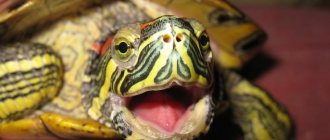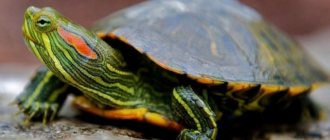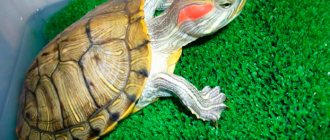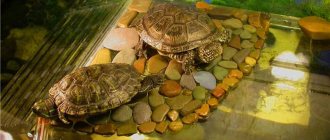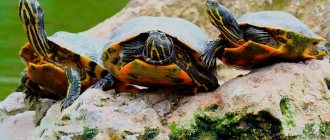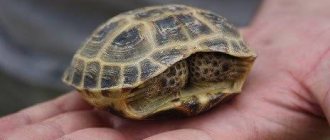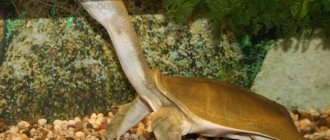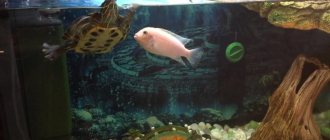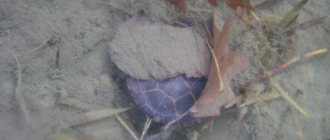Home/AQUATERRARIUM/Do-it-yourself aquarium for a red-eared turtle
When choosing a pet for yourself, it is important to know how to care for it and what to feed it. Be sure to arrange and choose comfortable housing. The right aquaterrarium for a red-eared turtle is the key to the health of your beloved pet.
Keeping a swamp turtle
photo can be enlarged
This species is not often found in aquatic turtle aquariums. Much more often, compatriots choose “overseas friends” than the inhabitant of the reservoirs of our country. The bog turtle is aquatic, which means it needs an aquarium with water. The nutrition of such an animal deserves great attention. The aquatic species is a pronounced predator, so it cannot feed on greens alone; such food will weaken it and make it sick.
You should not let your pet wander around the house or apartment on its own. After such walks, the animal very often gets sick due to drafts in the house. And in the dark, you can easily step on a turtle. You cannot keep several turtles of different sizes in one terrarium.
Keeping a red-eared turtle in an aquarium: features
The main rules for keeping a red-eared turtle in an aquarium are maintaining the required temperature and cleanliness of the living container. Also, do not forget to feed your pet and change its water. Red-eared turtles can eat fish - hake, perch, cod and crucian carp. They also love caviar. Adults eat the fish with the head, but young ones need to cut it into pieces. Young turtles need to be fed daily, while adults need to be fed 2-3 times a week.
Fish can be alternated with seafood: crabs, shrimp, octopus, squid, etc. But they need to be heated to room temperature. Insects can serve as additional food: locusts, grasshoppers, mealworms, snails, washed earthworms, bloodworms. Be careful with caterpillars, they can cause poisoning. You can also include dry food specifically made for turtles. In the 2nd year of life, pets can also be fed meat. It is better to exclude fatty varieties, but poultry and beef are quite suitable.
It is better to give plant food to older turtles that have already gained a little weight, throwing it in thin pieces directly into the water. For these purposes, it is recommended to use lettuce, cabbage, dandelion, seaweed leaves, vegetables, fruits, herbs, etc.
It is not recommended to keep a red-eared turtle without water for more than an hour, otherwise their skin may dry out. If you accustom your pet to handling from a very young age, it will get used to it and will not bite.
Design options
Terrariums can have different designs, each of which has its own special qualities.
Wooden structure
Most often, at home, these pets are kept in ordinary wooden boxes of appropriate sizes. This is a simple design that is easy to build and does not require special materials.
In addition, such items can always be found in a barn, garage or storage room. If you can’t find a suitable container anywhere at home, you can buy it inexpensively ready-made.
Wood and glass combination
Many breeders improve wooden structures by replacing one of the walls with frosted plexiglass. It is important not to forget about the ventilation holes.
You will be interested to learn about the features of keeping a land turtle, snapping turtle, Central Asian land turtle, fringed turtle, swamp turtle, Chinese turtle, snapping turtle, red-eared turtle.
In such variations, the floor is made of thin plastic or linoleum or laminate, and the roof has an upward opening or retractable lid.
Plastic container
This is an inexpensive, but very comfortable house for the ward. Its main disadvantage is the difficulty of installing a lamp to heat a turtle. It is important that this item does not threaten her life and provides the necessary amount of heat and light.
An alternative is to use commercial plastic rodent cages.
Did you know? All turtles are long-lived. In natural conditions they can live for more than a hundred years. For example, the oldest armored reptile in Europe is still considered to be a ward of the Galapagos Zoo named Harrient, who died in 2006. Then the animal turned 250 years old. But the most interesting thing is that on his life’s path he had the opportunity to meet Charles Darwin himself, who brought him to the European expanses
.
Floor pen
According to experts, this is not the best option for keeping a turtle. But at first, until the question of her permanent place of residence is resolved, you can fence off a corner for the ward right on the floor in the apartment.
The height of this fence should correspond to the size of the resident (we will talk about this in more detail later). It is important that the floor is insulated, otherwise the reptile will get sick and die. It cannot be kept on bare tiles.
It is advisable to cover the equipped pen with a piece of linoleum or a rubber mat. Remember that land animals do not respond well to open areas. The temperature in the room with the pen should not fall below +25 degrees.
Aquarium
Turtles adapt well to being kept indoors in a regular aquarium for aquatic fauna. They can provide an area for lamp heating, as well as ventilation holes. The disadvantage of this option is the high cost of the design.
Shelf in the sideboard
Not a bad option for an armored ward, but its arrangement requires a lot of effort on the part of the owner. It is important to ensure good mounting of the heating lamp, and this design must also be safe. Give preference to wide and high shelves so that the beast does not get burned.
Important! A turtle terrarium must have small pebbles. If the animal shows a tendency to swallow pebbles, immediately replace the mound with larger stones.
Aquarium decoration
The main principle of choosing decorations is safety. Do not use items made from environmentally hazardous materials or with sharp corners or edges.
The soil for the bottom should not be very fine, as turtles can sometimes swallow it. Also, fine soil quickly becomes contaminated and is difficult to clean. It is better to use pebbles with a fraction of 5-6 cm.
You can plant green plants for young turtles. Adults do not need soil, and they can eat or damage plants.
In an aquarium with red-eared turtles, artificial plants made of plastic or silk would be appropriate. They are secured in the ground using weights. You can also install artificial vines on the islands.
To decorate the terrarium, you can use a variety of driftwood, grottoes, unusual stones and other elements. The driftwood should not be fresh, as it will release harmful substances into the water. It is better to take pieces of wood that have lain in the water of a body of water for a long time. The bark needs to be removed from them.
Conditions for keeping the red-eared turtle
For the normal functioning of the animal, the following conditions must be observed:
- Water.
- Land.
- Temperature.
- Lighting.
- Use of ultraviolet lamps.
- Water filtration.
Water
In order for the turtle to swim freely and easily perform various maneuvers, the water level in the terrarium must be at least 40 cm. It should be changed once a week, but not completely, but only 30-40% of the total volume. Newly added water must first be left for 5 days.
Land
The red-eared slider is considered a swimming reptile. In addition to water, it can also be on land, crawling out to warm itself. This area should occupy 25% of the total area of the terrarium. The island should be attached to the base of the tank.
The top of the aquarium should be covered with glass with small holes to allow air to pass through. This is necessary to prevent animals from getting out.
The red-eared turtle is quite sedentary and spends a lot of time on land. You can arrange several islands for it. One may be in a shaded area, and the other in a brightly lit area.
Some points should be taken into account when arranging an island of land in a terrarium:
- A piece of land is made with a sloping shore, which should gradually rise from the bottom. It is not recommended to make steep cliffs.
- The island is made of high-quality material, and the surface must be rough so that the turtle clings to it with its nails and gets out of the water. You can place soil on it, but be sure to do it in such a way that it does not crumble into the water.
- If there are several red-eared turtles in the terrarium, then the area of the island is increased so that all the animals can fit on it.
- If there are several islands of land, it will be good if some are completely dry and others are slightly damp.
A piece of land is made 30 cm below the edge of the terrarium so that the animal cannot get out.
Temperature
The water temperature in the aquarium should be 23-28 degrees. If there are two islands of land, then one should be in a shaded place, and the temperature there should be 23-25 degrees. And on a warm island the temperature is usually 28-32 degrees. Such temperature changes are considered ideal for these animals.
To create this temperature, use a special aquarium lamp. A drop in temperature below 20 degrees has a negative impact on the health of this pet.
Lighting and UV lamps
In their natural habitat, red-eared turtles often crawl onto land to bask in the sun's rays. Aquaterrariums also need lighting, so incandescent lamps of 40-75 W are used for this. The lamp must be hung above the sushi island. The distance from it to the lamp should be such that the air warms up to 28-32 degrees. At night the lights are turned off.
Many owners of red-eared turtles do not even realize that these pets urgently need ultraviolet light, which helps the body absorb calcium and synthesize vitamin D 3. Their lack contributes to the development of rickets and even the death of the animal.
You should purchase a UV lamp that emits UVB and UVA rays. It is strictly forbidden to use a lamp with UVC rays, because they burn the retina, making the turtle blind.
The UV lamp is turned on every day for 12 hours. It must be installed from above at a distance of at least 30 cm from the ground. Replace the lamp once a year.
Water filtration
must always be clean
It is better not to use internal filters, because they quickly become clogged with suspended matter, losing their effectiveness.
The better the filter, the less often you will need to change the water in the aquarium. To ensure that the water is always clean, it is changed every week by 30-40% of its volume.
Main product parameters
The total land area should be 3-4 times the size of the turtle, and it is also worth considering that it will grow.
The ideal size of an island is 4 times the size of a turtle. If there are several reptiles in the aquarium at the same time, then in order to calculate the area of the island, you need to multiply the size of all turtles by 2.
It should be convenient for the pet to climb onto the island
The angle of inclination of the ladder in relation to the piece of land should be 35-40 degrees, so that it is convenient for the turtle to climb onto it. The side surface of the glass facing the front side of the aquarium should be 2-3 cm away from it, in this way it will be possible to avoid a seam that distorts the appearance.
The distance from land to the top border of the aquarium should be 15-20 cm so that the turtle cannot leave it.
Performing filtering
Every turtle aquarium must be kept clean. The health of the pet depends on the state of the liquid in the aquaterarium. It is best to equip an aquarium for turtles with an external filter. In this case, absolutely any model and type of device will be ideal.
Experts do not recommend installing the filter directly into the water, as it becomes clogged very quickly and completely loses its effectiveness. Please note that the better the filter does its job, the sooner you will have to change the water in the aquarium itself. However, it is still recommended to maintain ecological balance. To do this, it is advisable to change half the volume of available water once a week. Before replacing, the liquid must be allowed to settle.
Preparing the water
As already mentioned, the water in a turtle house should be 40 cm deep. This is necessary so that your pet can maneuver freely in it. The terrarium for red-eared turtles should be cleaned quite often, but it should be taken into account that the water for it must settle for at least 5 days. It should not be changed completely, but partially - about one third of the volume. This procedure should be performed at least once a week. To replace, you must use water at the same temperature as in the terrarium pool.
How to properly equip a plot of land
When buying a red-eared turtle, be sure to keep in mind that such a reptile leads a sedentary lifestyle. She spends a lot of time not only in water, but also on land
Therefore, it is very important to create the right island. It will be better if he is not alone
In this case, one part of the land should be brightly lit, while the other should be in the shade. Typically on land, turtles enjoy ultraviolet light and also feed on oxygen.
So, when creating land plots, it is very important to pay attention to the following nuances:
land should make up at least a quarter of the total space in the aquaterrarium; at the same time, the islands must have a smoothly rising shore so that the animal can simply climb on them. You cannot create steep cliffs, as the pet may fall and get hurt; It is very important to pay attention to the material from which the surface itself is made. It should be of the highest quality, and its texture should be rough; if several individuals live in your aquarium at once, then make sure that each of them can be on the surface at the same time; if your aquarium contains several land areas at once, then you can make sure that some of them remain completely dry, while others are slightly submerged in water. In this case, the land areas should be located in such a way that the animal cannot independently get out of the aquarium
In this case, dry areas should be located in such a way that the animal cannot get out of the aquarium on its own.
Temperature
The recommended water temperature for the red-eared turtle is 23-28 °C. The temperature on a shaded (cold) island of land should be 23-25°C, and on a brightly lit (warm) area - 28-32°C. This is an absolutely ideal option for arranging the most suitable temperature conditions for the red-eared turtle.
To create such temperature conditions, heating is necessary. The main heating is carried out using a special lamp, which is fixed above one of the islands. If the temperature when heating with a lamp is insufficient, then additional heating is used.
You can use a heater in the form of a long glass tube that is immersed in water. Particular attention should be paid to its location: the turtle should not be able to accidentally bite the electrical wire or damage it with its shell.
Ultraviolet lighting
The main principle of keeping turtles in captivity is to create a natural environment. In nature, turtles love to bask in the sun, so in an artificial pond you will need:
- An incandescent light bulb is placed over land to achieve a temperature of 23-28C. At night the lights are turned off.
- The most significant aspect in keeping red-eared turtles is considered to be ultraviolet lighting, with the help of which the reptiles absorb calcium, which is necessary for the strength of the shell. In terrariums, UV lamps must be installed at a distance of at least 30 cm from the soil. Daylight hours are 12 hours.
Conditions and equipment
When setting up an aquarium, you should first place all the necessary equipment in the tank and make sure that the conditions created are acceptable for keeping turtles. In aquaterrariums the following is installed:
- heater;
- filter;
- lighting;
- Ultraviolet lamp.
The heater is installed to maintain the required temperature: in dark areas 23–26C, in illuminated areas – 28–30C. The main heating is created by a special lamp located above the land islands, but if this is not enough, then another device is additionally installed.
External filters are used for aquariums, as internal ones quickly become clogged. Water changes are carried out weekly, replacing 40–50% of the liquid with settled water.
A UV lamp is one of the most important devices for the life of turtles. Ultraviolet radiation helps animals synthesize vitamin D3 and absorb calcium, and without it, pets will simply die. Ultraviolet daylight should last 12 hours, and only UVB and UVA rays are suitable.
Heating
The water temperature is kept in the range of 26-32⁰С. To simplify control, manufacturers offer heaters in the form of a glass tube with a built-in thermostat. Flexible heating cables are not suitable: the turtle digs up the wires and bites them.
An incandescent lamp is fixed above the island. The temperature under it at the level of the shell is 30-32⁰С. The pet crawls out here to warm itself. Heat activates the immune system, metabolism, and promotes digestion. If a turtle has a soft shell or crooked limbs, it means it lacks calcium. For normal absorption of microelements and the formation of a healthy skeleton, ultraviolet (UV) radiation is necessary. The aquaterrarium is equipped with a UV lamp.
Choosing an aquarium
When choosing the size and type of aquarium, it is necessary to take into account the dimensions of an adult animal and the characteristics of its body. Red-eared turtles spend a lot of time underwater or at the bottom of an artificial reservoir, where they feel safe.
The volume of the aquarium is selected depending on the size and number of turtles. For one turtle 13 cm long or a pair of young individuals 10 cm long, a 100-liter aquarium will be enough. As the container grows, it is replaced with a larger one. So, for a pair of turtles 20-30 cm long, you will already need a two-hundred-liter aquarium.
If the volume is too small, the water becomes contaminated faster, which leads to red ear disease.
The red-eared slider is a swimming reptile. In addition to water, it vitally needs land on which it basks and receives an ultraviolet tan. The recommended size of the land area is at least 25% of the total area of the aquarium. It is advisable to firmly attach the island to the base of the container.
The container should be equipped with a lid so that pets cannot move it and get out, but at the same time it allows air to pass through well.
Island for relaxation
Terrariums for red-eared turtles must have a piece of land where your heat-loving pet can rest and warm up. Its size should be equal to approximately a quarter of the entire home.
Such an island is usually a pile of pebbles secured with sealant. Wooden parts should not be used, since this is an unstable material and, by absorbing water, it will create conditions for the appearance of mold. But natural driftwood, as well as tree bark, can be used for these purposes.
Be sure to install lamps above the island. By warming up under them, the turtle strengthens its immune system. You can use a special device for these purposes - a thermostat connected to a glass tube. It is very practical and affordable.
When creating a terrarium for red-eared turtles with your own hands, you can save time by purchasing a ready-made island at a pet store. These devices meet all the requirements of the inhabitants of the terrarium - they have a rough surface made of waterproof plastic so that the turtle’s paws do not slip on it.
A terrarium for red-eared turtles must meet safety requirements - pebbles should not have sharp edges. Their size should not be too large to prevent animals from swallowing them. It is better to replace the green plants of a regular aquarium with various driftwood and caves.
Remember that when you choose a red-eared slider as a pet, you are responsible for its quality of life.
Aquarium decoration
Designing an aquarium for turtles is a creative process in which every owner can show their imagination and test themselves as a designer. However, in pursuit of beauty, one should not forget about the design rules, the purpose of which is to create comfortable conditions for pets. How to set up an aquarium for turtles correctly and aesthetically:
- Decor - when decorating a container with decorations and decorative elements, items made from environmentally friendly materials are used. Elements with sharp edges or made of plastic cannot be placed in aquariums. To give the pond a picturesque look, pebbles, driftwood and shelters are placed in aquariums.
- Soil - substrate for the bottom is used in the middle fraction, since small particles are swallowed by turtles. In addition, the fine substrate quickly gets dirty, and cleaning it is a labor-intensive process.
- Vegetation - live flora is used in aquariums with young turtles, since adult pets can eat grass. It makes more sense to place artificial silk vegetation in a container, securing the flowers with weighty objects or weights. Areas of land can be decorated with artificial flowers.
Keeping and caring for red-eared turtles requires investment of effort and time from the owner of the reptile, but the work will be rewarded with good health and vigor of the pet. Having acquired a cute turtle, you should provide the reptile with a properly equipped house, where the pet will grow and develop, bringing joyful minutes and moments.
How to choose the right turtle for your home
When choosing a charming reptile, howbuysell advises paying attention to several nuances at once
When to buy?
The best time to purchase a pet is to choose the period from late spring to early autumn. In the warm season, it is less likely that the animal is sick and will not catch a cold while it is being transported to a new apartment.
Where to buy a turtle for your home
Immediately give up the idea of buying a turtle from strangers or at a flea market: this way you can end up with an individual infected with some disease or an individual protected by the Red Book. It is best to contact breeders, specialized stores or nurseries.
When purchasing, ask to see a veterinary certificate (copy) about the animal’s health status, take the sales receipt.
Health Indicators: How to Choose a Healthy Turtle
- Turn the turtle over onto its shell - if the individual is sick, the legs will simply hang.
- If you bring your finger to the animal’s head, it will quickly retract into the shell.
- The nose and eyes must be absolutely clean, without any discharge.
- Take courage and look into the reptile's mouth - there should not be any plaque or wounds with defects. The palate and tongue should be clean and slightly pink.
- A healthy turtle should not breathe through its mouth.
- The shell must be without a single flaw: there should be no chips along the edges, scratches or stains.
Now you know the general rules on how to choose the right turtle. It remains to decide which type is preferable. The most unpretentious are the land (Central Asian) and red-eared turtles.
Note!
There are aquariums in which red-eared sliders cannot be kept:
- Small turtle tanks with a volume of up to 50-70 liters. They can only be used for temporary housing of animals. If a turtle lives in such a container for a long time, then it develops skin infectious diseases, dystrophy and softening of the shell.
- Aquariums in which the land is made of plastic.
- Aquariums in which it is impossible to set the desired temperature, as well as ultraviolet light and filtration. The absence of all these conditions leads to illness and death of turtles.
Thus, caring for a red-eared slider, like any other pet, requires some effort. But a terrarium in which the water is clean, the bottom is picturesque, and the animals are healthy is a fascinating sight that is worth the time and effort.
The presenters of the Karusel TV channel will tell you how to properly equip a terrarium for a red-eared turtle:
https://youtube.com/watch?v=oMCE_7iBuQ0
Interior
It is much easier to arrange an interior for a land turtle than for an amphibian.
There is room for your imagination to run wild here. To decorate the bottom, you can use coconut bark or medium-sized smooth pebbles. Do not use small pebbles, sand, gravel, etc. A turtle can swallow such small things and harm itself. Turtles do not perceive transparent walls and can constantly hit the glass. If the terrarium is made of glass, then it is better to cover it with a non-transparent film to a height of 10-15 cm.
For turtles, you should organize a small shelter where she could quietly spend part of her time. Place this house in a cool, unlit corner. To do this, you can use an old, unnecessary pot, turning it upside down and providing access to the turtle inside the pot. A feeder with food for the turtle is installed only during feeding. As soon as the turtle eats, the feeder is immediately removed.
In addition to food, turtles need to be provided with access to water by installing a small “bath” in the place where they eat. Its design should allow the turtle to easily enter the water and just as easily exit it. The water level should be at half the level of the shell. It is advisable to change the water in the mini-pool every day.
In conclusion, we can say that this is not enough: a turtle, like all animals, requires not only care and feeding, but also basic attention
And the attention is to ensure that the turtle receives adequate nutrition and lives in clean conditions with temperature maintained within optimal limits
Neighborhood
A do-it-yourself terrarium for red-eared turtles allows your pet to be close to aquarium fish. Of course, it is undesirable for them to be in the same “house” - this can provoke frequent conflicts between its residents. In this case, it is better to use a vertical glass wall that will separate the aquarium for the fish and the terrarium for the turtle. There should be holes in the partition so that water can pass freely, but residents of the aquaterrarium should not penetrate through them into the neighbors’ territory.
In the part where the fish will be located, the bottom of the “house” can be decorated with special plants. Don’t bother creating a beautiful design on the turtle’s territory; it won’t appreciate your worries and will happily eat the green spaces.
What should a “home” be like for a turtle?
Terrariums for red-eared turtles represent a mandatory water space and an island of land. But you should know that the pool for a turtle should be three times larger than its dry part. Therefore, such animals are kept in aquaterrariums. These are ordinary aquariums that can be purchased at almost any pet store. Usually their average volume is at least 100 liters.
The layer of water should be 40 cm. To prevent your pet from traveling around your home, the terrarium for the red-eared turtle must be covered with a glass or plastic sheet with perforations, which serves for sufficient air exchange.
Do-it-yourself aquarium for a turtle: master class
First, determine the dimensions of the aquarium, then calculate the length and width of the individual glasses (for the usual rectangular version you will need 5 pieces). Cut out the parts for the aquarium. It is better to take the glass thickness from 5 mm. To cut it, it is recommended to use a special glass cutter; the measurement accuracy should be with a discrepancy of no more than 1.5 mm.
After cutting the glass, be sure to sand it, removing sharp edges. It is necessary to grind the edges, especially the corner ones, and not the entire surface of the end. You can work at home with medium grade corundum sandpaper under a stream of water.
To glue an aquarium you need silicone, special sealed glue, 96% alcohol, and narrow tape. To assemble the glass, you need to lay it out so that the uneven sides are at the top and the perfectly smooth sides are at the bottom. The blanks are placed in the following order: side, front, side, front. Align the edges joint to joint.
Apply tape to the glass joints. Before doing this, make sure that the workpieces are attached tightly and the edge is smooth. Apply the adhesive tape so that on the first side, where the bottom will be, it is not glued by 1 cm. Fold the edges of the unfolded aquarium blank. Apply the side that has the tape on the edge first. Align this half evenly and place the side on it where there is no tape on top. Align the parallel, then place the bottom on top and align the seams so that there are no distortions.
Degrease the seam joints with alcohol and fill with silicone (from bottom to top). Work seams from edge to edge. When gluing the aquarium, try to fill everything evenly. Clean off excess silicone from the bottom and corner seams. Leave the finished aquarium until it hardens (the silicone sets in about 1 – 2 hours). When it dries, apply more layers of silicone to the inner corners of the bottom and walls (remove the tape before doing this). You can pour water into the finished aquarium and equip it only after a day.
❶ How to set up a terrarium for a turtle :: Equipment and accessories
How to set up a terrarium for a turtle
Turtle lovers buy one of two types of reptiles: either the Central Asian or the red-eared turtle. To provide animals with conditions as close as possible to natural conditions, owners have to equip a terrarium. The Central Asian tortoise lives in burrows in the wild; it is accustomed to digging up everything with its powerful claws. Imagine what noise there will be in the apartment if the terrarium is covered with a layer of sand and stones. And if it is naked, the turtle may get sick and die. Therefore, it is better to get a red-eared turtle.
Instructions
1. Take an aquarium glued together from sheets of natural or organic glass. Remember that it should be spacious enough, given that the turtle grows quickly. Please also note that the water will have to be changed frequently, so immediately think about how you will drain the contents of the terrarium - either using hoses, or by equipping the bottom with a shut-off valve.
2. Divide the aquarium-terrarium into two zones: aquatic and land. Indeed, in the wild, the red-eared turtle periodically crawls out of the water. Therefore, across the narrow part of the aquarium-terrarium, glue a horizontal sheet of glass to the side walls or install it on fixed supports. Its width should be from 1/4 to 1/3 of the length of the aquarium.
3. Attach an inclined glass plate along which the animal can get out of the water onto land. Please note that the surface of this plate must be rough, otherwise the turtle will simply slide down it back into the water. It wouldn’t hurt to also roughen the surface of the seating area. The easiest way to achieve this is to rub them with coarse sandpaper before installing the plates in the aquarium.
4. Try to correctly determine the total height of the terrarium and its land part. It should rise slightly above the surface of the water so that the turtle can dry out. But the depth must be sufficient for the turtle to swim and dive freely. Again, keep in mind that the animal will grow quite quickly and that there should be a high enough side above the land part so that the turtle does not accidentally fall over it. In any case, the height of the side above the water level should be at least 20 centimeters.
5. Choose the sunniest place in the apartment to install the terrarium. If there is a lack of sunlight (in winter or during prolonged inclement weather), you will have to irradiate the turtle with an ultraviolet lamp from time to time.
6. Plant aquatic plants. Then the terrarium will be much more beautiful, and after some time the turtle will begin to eat them.
KakProsto.ru>
Tools and materials required for work
The most practical and inexpensive design is made of plywood and plexiglass.
It will also be useful for you to find out why a turtle does not open its swollen eyes, how long a turtle lives at home and in the wild, what turtles eat, why and how to inject Eleovit into turtles.
In order to build a homemade terrarium for your pet, you will need:
- saw or jigsaw;
- a sheet of plywood from which 4 parts will need to be cut, measuring at least 90 x 50 cm (can be replaced with plastic);
- glue gun or screws for fastening parts;
- thin wooden strips for securing the walls;
- corners for side walls;
- 2 slats with grooves for glass;
- drill;
- silicone glue;
- plastic covers to cover ventilation holes;
- lamp for heating the animal (it is advisable to provide a special protective lampshade for it);
- feeders;
- drinking bowls;
- a piece of linoleum on the floor;
- special bedding (soil);
- swimsuit;
- hygrometer;
- thermometer.
Caring for a turtle at home
Arrangement of living space
Pet turtles should not wander around the apartment randomly. Keeping turtles requires organizing a separate closed space for them: a terrarium or an aquarium with special equipment.
List of necessary equipment (for all types):
- room/container for keeping (terrarium/aquarium);
- ultraviolet lamp (for water UVB 5–10%, for land 10–12%);
- heater/heating lamp;
- lamp;
- thermometer for temperature control$
- stable feeder.
For land turtles, this list includes a house for sleeping and resting.
Additional equipment for aquatic species:
- 100 Watt water heater;
- filter (internal or external);
- land/shore/island.
Although red-eared aquarium turtles spend most of their time in the water, provide them with a warm, dry place on land to rest and get UV exposure. The turtle will not turn it over if one side is submerged in water. Requirements for material for sushi: non-toxic, not smooth, but rough, without sharp corners. Observe the following proportion: water - 3 parts of volume, land - 1 part.
In their natural environment, turtles climb onto snags, stones, and stable objects protruding from the water. It should also be convenient for them to climb onto the artificial shore in the aquarium.
The required aquarium volume for a red-eared turtle is from 200 liters. The more spacious the home, the healthier the animal.
For land use, you need a terrarium with a capacity of 100 liters or more. Entirely glass or made of wood, but with one wall made of transparent material.
House
So that the pet can sleep peacefully, relax, and hide, it needs a home inside the terrarium.
A ceramic flower pot, divided in half, with processed edges, is suitable for the house. Use a plastic rodent house for this purpose or make one out of wood.
Priming
In terrariums, use hay as soil - it is easy to change. Do not put sand on the bottom as animals will swallow it. Lay a two-layer coating: sand at the bottom, large pebbles at the top. The turtle sharpens its claws on it.
Do not put newspapers, expanded clay, sharp stones, or cat litter in the terrarium.
Aquatic turtles do not need soil. For aesthetics, place large stones at the bottom of the aquarium. Gravel or other covering will not work; the animal will swallow it.
Water
Clean water and a maintained temperature level are the most important things in keeping aquatic species.
In the water, the red-eared turtle swims, sleeps, eats, and goes to the toilet. To prevent ammonia, nitrates and unpleasant odors from accumulating, change the water a couple of times a week. At the same time, carry out filtering.
- 70% - plant foods (lettuce, cucumber, zucchini, nettle, algae, duckweed);
- 30% - animal (meat, fish, seafood, worms, insects, bloodworms, guppies).
Aquatic turtles are omnivores. Feed regular food and artificial food, fish food, aquarium plants and insects.
Feed turtles up to two years old once a day. During this period, animal protein predominates in their diet. As the animals grow, the proportion of plant feed increases.
Vegetables are included in the diet, even if the animal does not show an appetite for them. The older it is, the more fiber it needs.
Aquatic turtles use water for swallowing as they do not produce saliva. They eat in the aquarium. It is better to feed them in a specially designated place, this will keep the home clean longer.
Hygiene
Cleaning the premises
Clean the bottom and walls of the terrarium from animal waste products every day. Wash feeding and drinking utensils whenever they become dirty.
The aquatic turtle's aquarium also needs general cleaning twice a month.
Bathing
Caring for land turtles includes weekly water treatments. Place the animal in a small container with warm water at a temperature of 30–35 degrees for half an hour. The head should be above the water. Dry your turtle after bathing.
Trimming claws
During their lives, these animals grow a shell, beak and claws. Care for your pet turtle's claws.
When the beak and claws grow to such a size that it becomes difficult for the animal to move and eat, remove them. For this procedure, special nippers are used.
Such actions are not done with aquatic species of turtles.
Shedding
Turtles are susceptible to molting.
In aquatic species, the separation of large scales on the shell and the change of skin occur regularly throughout life.
Land turtles only change the skin on their paws, this happens unnoticed.
Terrariums for land turtles
New owners of such a pet naturally have a question about how to arrange a terrarium for a land turtle so that it has everything necessary for its long and healthy life. This should be a separate and rather large box made of glass, plastic or plexiglass with all the necessary equipment. You can make it yourself, order it from specialists, or purchase a ready-made version.
Terrarium size for a land turtle
Depending on the number and size of animals, the size of the terrarium for land turtles will vary. So, for one small turtle (6-15 cm in length) a space of 60x50x40 cm is enough. If there are two such babies, then the size of their house increases to 50x50x100 cm. As the number of inhabitants increases or their size increases, the terrarium should grow proportionally. In a simplified way, you can calculate the required size based on 2-6 sizes of the turtle in width and length.
How to set up a terrarium for a turtle?
When we have decided what size and what material the turtle terrarium should be made of, it’s time to start filling it. So, what should a turtle have in its terrarium:
- incandescent lamp or infrared lamp for heating the air;
- UV lamp UVB 5-10% (special for terrariums);
- thermometer to control the air temperature, which should not fall below 25°C;
- soil (pebbles, sawdust, sand and their combination);
- house (a shelter where the turtle can retire);
- place for feeding (saucer or large flat stone);
- swimming place (shallow tank).
Soil for a land turtle in a terrarium
When thinking about how to set up a terrarium for a turtle, we immediately imagine a cozy bedding made from natural materials like pebbles or wood chips. The soil, by the way, performs not only an aesthetic function, it helps to absorb liquid waste products of the animal and helps preserve its limbs without scuffs and deformations when moving along the bottom. The best options for filler in a terrarium for turtles:
- Alder chips. It does not generate dust, does not have a pungent odor, and does not threaten the pet with splinters. The cost of this filler is low and you can buy it at any pet store or supermarket in the “Everything for a Picnic” section.
- Straw or hay. You can store your own grass from the summer and dry it. If desired, the turtle can even have a snack with this filler.
- Pebbles. Smooth and without sharp edges, it must be larger than a turtle's head so that it cannot be swallowed. The stones are useful because they naturally wear down the claws. In addition, during the day it heats up from the lamp and gives off its heat during the night. Pebbles can be collected at the bottom of a pond or bought at a pet store. Before filling into the terrarium, the stones need to be thoroughly calcined in the oven for disinfection.
- Sawdust and sand. Not the best option as they are easy to swallow which is not good for the turtle's health. In addition, both fillers generate a lot of dust, and when wet they can lead to colds. On the other hand, these types of soil are affordable and absorb liquid animal excrement well. Alternatively, sawdust and sand can be used in combination with other types of soil.
Lamp for terrarium with turtle
A home terrarium for turtles should be equipped with two lamps - with a heating lamp and with an ultraviolet lamp. Since the turtle really needs warmth, a heating lamp is a must. This can be a regular incandescent lamp or a special lamp without visible light (infrared). It is placed 30 cm from the bottom of the terrarium. The air under it should warm up to +32°C. This indicator is adjusted by changing the lamp power. You need to hang the heating lamp in the corner opposite from the shelter so that the turtle feels the temperature contrast in these zones.
An ultraviolet lamp is especially necessary for land turtles for better absorption of calcium, which is important for the strength of the shell and limbs. Without such a lamp, the bones become brittle and the shell becomes severely deformed.
Depending on the type (compact or tube lamp T5, T8), they are installed either in a regular base or in the grooves of a special lampshade. If the lamp is mercury, it is connected through a special starter.
Cautions
Pay attention to aquariums in which red-eared turtles cannot be kept:
- small containers up to seventy liters. Only babies can be kept in such aquariums. If you place large individuals in them, then very soon you will notice how the animal will begin to get sick, its integument will be damaged by skin infections, and its shell will soften;
- You should also not use containers in which the dryer is made of plastic or other bad materials;
- Never use containers in which you cannot install a filter for water purification, as well as special lamps. In poor conditions, turtles very quickly begin to get sick and die.
As you can see, caring for a red-eared slider, just like any other pet, has many nuances. Therefore, you need to approach with all responsibility to create comfortable conditions for your beloved animal. However, with a little effort, you can create a truly picturesque corner of your home.
Necessary requirements and dimensions
If turtles lead a silent lifestyle, do not think that they will be happy with any conditions that you provide them. Please note that by bringing such a ward into your home, you will be dealing with a very demanding reptile.
Do-it-yourself aquarium-terrarium for a turtle: video
Important! It is strictly forbidden to feed the turtle with piece food for cats and dogs. It is also detrimentally affected by keeping it in a small terrarium, the lack of special soil and regular walking.
The first thing you need to pay attention to is the size of the structure. Experienced breeders advise calculating the required area, guided by the following rule: the length, height and width of the structure should be increased from the dimensions of the reptile by 2 - 6 times.
That is, if the diameter of a turtle is 10 centimeters, then the parameters of its abode should reach half a meter. This also applies to the height of the terrarium, which is also measured taking into account the length of the animal. In cramped conditions, this value can be multiplied by 2.
If you plan to keep several pets, then you will have to calculate the area for them for each one separately. For a couple of ten centimeter household members, you need a cubic structure with sides of about a meter. Remember: the more space, the more comfortable your pets will be.
The material for a turtle's home must be selected based on its size and the endurance of the ward. That is, small structures for heat-loving animals can be built from wood, while plastic is suitable for cold-loving animals.
Also consider the possibility of thermal insulation of the walls using polystyrene foam. Ideally, turtles that like the cold should be kept in separate rooms from those that prefer a lot of heat.
If this is not possible, you will have to build a special terrarium stand, placing more hardy living creatures in the lower tiers.
Did you know? Sea turtles have a unique feature that is rightfully considered a record among all spinal animals. They tend to hold their breath for more than 10 hours.
Each turtle breeder should bring the home conditions of his charges as close as possible to natural ones. Only then are they guaranteed good health and longevity.
